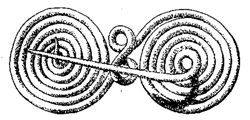This section is about how Roman engineers created an ingenious detail that was to have great significance for the development of the field of mechanics.
Some 2,000 years ago, the Romans were establishing a gigantic empire. They built countless beautiful architectural monuments, and their technological concepts and inventions continue to astonish. Such as the spring for locks.
 The Greeks had discovered the springy properties of metals 1,000 years earlier. The Romans made use of these properties for buckles and fibulas – pins that worked like “safety pins”. At the same time, they discovered that the springy properties could be used in a different area – locks. Utilizing the elasticity of metals to control the mechanism in lock constructions was a brilliant idea.
The Greeks had discovered the springy properties of metals 1,000 years earlier. The Romans made use of these properties for buckles and fibulas – pins that worked like “safety pins”. At the same time, they discovered that the springy properties could be used in a different area – locks. Utilizing the elasticity of metals to control the mechanism in lock constructions was a brilliant idea.
The Romans were the first to begin manufacturing locks in which all parts were metal. This allowed the invention of the padlock, and the simple wooden pin tumbler locks of the era became much more manageable with metal. The first modern locks were created using steel springs combined with metal lock housings. The designs were more reliable and easier to manage, and these lock concepts have worked even into our day. With the expansion of the empire, Roman locks became widely distributed.
Today’s locks and security solutions
Welcome to ASSA ABLOY’s product pages for more information about today’s locks, access control, mobile keys with NFC, door automatics and more. In the ASSA ABLOY solution pages you can experience lock and security solutions for any door opening.